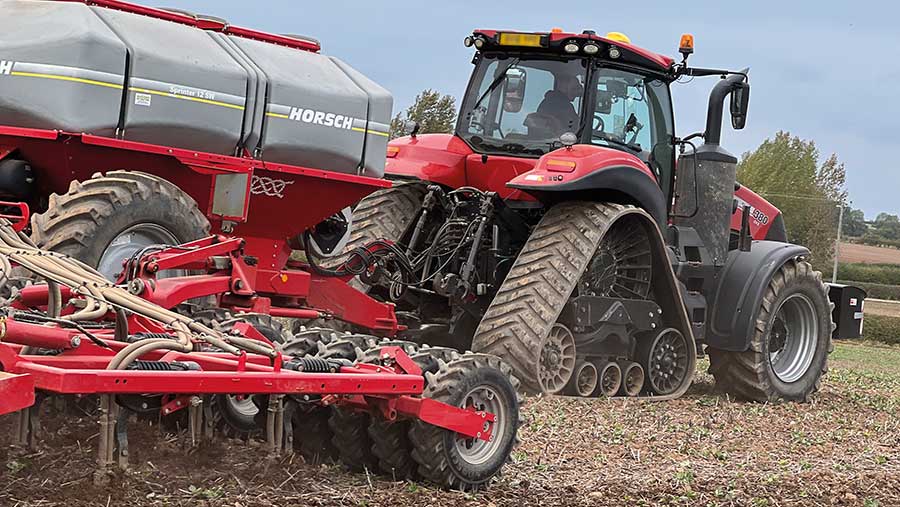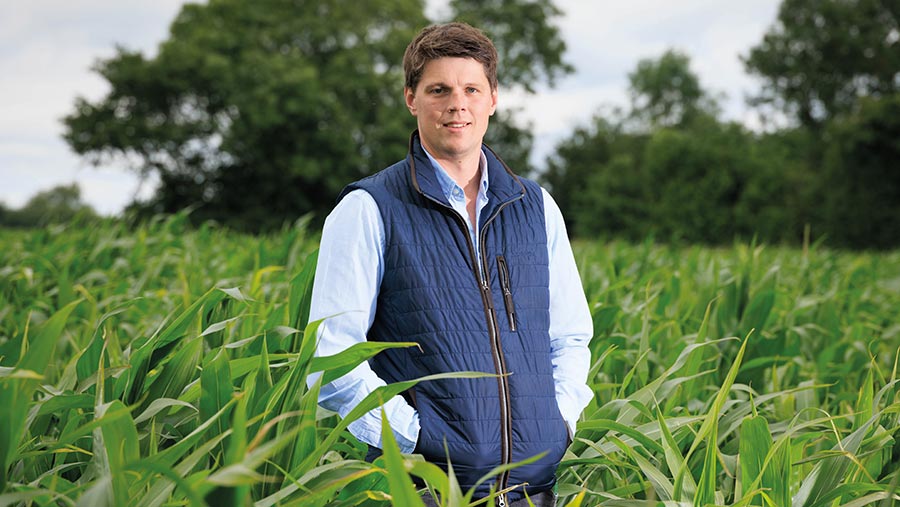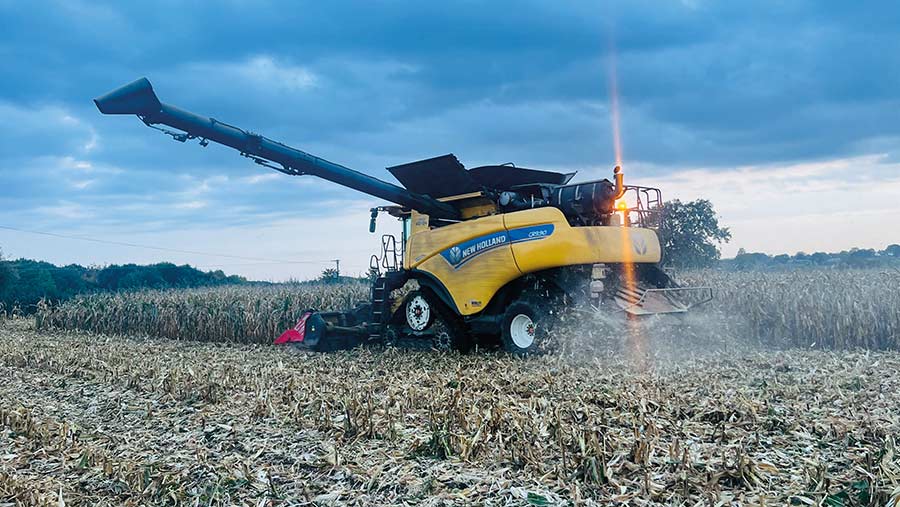Why grain maize is key break crop in arable farmer’s rotation
 © Will Oliver
© Will Oliver The demise of oilseed rape as a break crop has left a gaping hole in many rotations, but for one East Midlands farm, grain maize enables a better use of manures as well as helping to manage blackgrass and improve soil health.
After another successful season, maize has cemented its place at Swepstone Fields Farm, and Will Oliver has turned his attention to refining his establishment approach.
This spring, he is trialing strip-tillage to save on diesel costs, as he only needs to cultivate 30% of the total field.
See also: Farm trial shows slurry additive boosts digestate N value
Farm facts
- Area 850ha
- Cropping Includes 400ha winter wheat, 200ha grain maize, 160ha winter beans, and the rest in grass/Countryside Stewardship
- Establishment Based on 12m Horsch Sprinter tine drill with 6m Amazone combi drill as backup. A 6m Horizon DSX direct drill is on order
- Soils Mainly clay/loam with some lighter land
No OSR
Up to 2019, oilseed rape was a key break crop at the 800ha farm, but it became too risky to grow.
“It was no longer the big earner due to cabbage stem flea beetle damage and high erucic acid levels,” he says.
On top of this, they also had issues with blackgrass, and he says OSR just hid the grassweed, so it was part of the problem, rather than a solution.

Will Oliver © Tim Scrivener
He decided to drop the crop and has no regrets. “I adore not growing OSR.”
Second wheat was also dropped from the rotation because of its poor returns and blackgrass risk.
Winter beans were already being grown, so he looked for another break crop and discovered there was a local market for grain maize with GLW Feeds at Shepshed, a few miles down the road. The grain is marketed through Frontier.
“There is a market on our doorstep and it is pretty easy to deal with – there aren’t the rejections you can see with milling wheat.”
Good returns
Back in 2019, he grew the crop for the first time and last harvest (2022), it yielded an average of 7.5t/ha dried, and delivered good returns with an average price of £284/t, compared with £160/t last year.
The gross margin is on a par with milling wheat, despite drying costs doubling from £20/t to £40/t. He explains that the maize is harvested at about 30% moisture and needs to be dried to 15%.
“We can dry 8t/hr and in a 24-hour day that’s 190t. So we don’t combine more than that in a day to avoid it sitting around.”
To help compensate for the higher cost, he is making sure the business’ diesel use is efficient, cutting unnecessary cultivations.
His eventual aim is to direct-drill everything except maize, which will be strip-tilled.

© Will Oliver
Strip-till trial
This spring, he is trialling an area of the maize established using the strip-till approach. The trial area will be cultivated with a Horizon SPX strip-till tool and seed planted with a Horizon PPX.
He explains that the drill has auto depth control per row, enabling variable-depth drilling based on soil temperature, which will help even up emergence.
The rest will be cultivated with a Vaderstad Top Down and precision-drilled by a contractor.
“With a strip-till drill on an eight-row planter, we are cultivating just 30% of the field.”
Mr Oliver also plans to direct-drill wheat after the maize, to reduce the risk of not getting the crop in. He currently uses a Horsch Sprinter tine drill which struggles in wetter conditions.
He recalls last autumn, when the maize was harvested by 28 October. It rained for a period after harvest and he struggled to get parts after a breakdown.
“We had a 10-day window of not drilling and this may have cost us a bit in delayed wheat establishment this season.”
The 6m Horizon DSX direct drill will, hopefully, be part-funded through the Sustainable Farming Incentive (SFI), which pays farmers for direct drilling.
More information will be disclosed in summer 2023 by Defra.
The plan is to direct-drill after the combine leaves the field. Maize takes moisture out of the ground, resulting in more ideal seed-beds.
Using the Horizon direct drill will reduce diesel use from the current 60 litres/hr with the Horsch Sprinter to 6-8 litres/hr .
The drill has three compartments, so that a companion crop can also be established, which will be useful for the SFI companion crop option.
The Horizon can cope with the maize trash and it will also drill direct into a standing cover crop, if needed.
To help break down the maize residue, Mr Oliver applies Boost, a molasses product, to stimulate soil microbes.
The residue is also good for weed suppressionand is helping improve soil organic matter levels. Maize also follows a cover crop, which is grazed off by sheep.
Maize benefits
- Later drilling enables a preceding cover crop eaten by sheep
- Later drilling also has blackgrass benefits
- Plenty of crop residue helps improve soil health
- Allows for better use of organic manures
- A true break crop for wheat and beans
- Fewer sprayer passes than wheat or beans
- Later harvest fits in with delayed wheat drilling for blackgrass. Later drilled wheat also lessens risk from barley yellow dwarf virus and brings savings in pre-emergence herbicides
Nutrients
One key benefit of growing maize is that organic matter can be applied in spring when it is growing, rather than in early autumn before the oilseed rape.
The crop uses the nutrients and hardly any bagged nitrogen is applied to the crop, except when it is grown near the glamping site, where no manure is applied.
It will receive either sewage sludge, digestate or poultry manure, depending on soil test results and needs. For example, sewage sludge offers more phosphates.
After the maize, they will drill Skyfall and Siskin, which both perform well in the late drilling window.
Later drilling is ideal for blackgrass control and it also reduces the risk from barley yellow dwarf virus and foliar disease. It also enables Mr Oliver to reduce his pre-emergence herbicide spend.
Maize agronomy
Grain maize agronomy is virtually the same as for crops grown for forage and anaerobic digestion.
Good establishment is key to getting the crop away quickly, and Will Oliver waits until soils reach 8C, which is typically in April.
He grows three varieties: Fieldstar, LG30.179 and Prospect. These were selected for their early harvest timing and lower lodging risk, as grain maize needs to stand longer than forage crops.
The target population is lower than for a forage crop, drilling at 80,000 seeds/ha compared with 100,000 for forage maize.
Maize can suffer from early weed competition, and Mr Oliver uses both pre- and post-emergence herbicides.
The crop receives a pendimethalin pre-emergence application, followed by a post-emergence spray of Elumis (mesotrione + nicosulfuron).
Disease control is pretty straightforward with a single spray of the strobilurin Comet (pyraclostrobin) to protect against eyespot and leaf blight.
One downside is that maize is prone to crow issues, although pigeon control was a problem with oilseed rape. “It involves intense crow management at the early stages,” he says.
Strip-tilling may help by leaving some vegetation in the uncultivated strip, making it less attractive to crows.
Quite often you see crows preferring the open, bare areas of fields, but the challenge will be to not cause any competition to the young maize plants.
One key difference with forage maize is harvest, which involved buying a special header to fit the farm’s combine.
“We invested in the harvesting side, as this enables us to be timely when cutting since there are few contractors who have the necessary kit.”
In contrast, there are plenty of maize drilling contractors. Mr Oliver is now looking to invest in the establishment side, moving to a strip-till approach.
The Farmers Weekly 2023 Arable Farmer of the Year Award is sponsored by Fendt
 Farmers Weekly 2023 Arable Farmer of the Year is sponsored by Fendt.
Farmers Weekly 2023 Arable Farmer of the Year is sponsored by Fendt.
Enter yourself or nominate someone now on our Awards website

